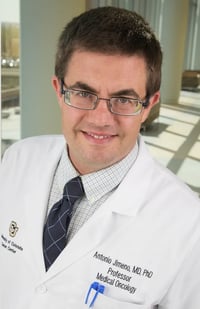Nearly two thousand people living in Colorado will be diagnosed with head and neck cancer (HNC) in 2020. Generally, a very aggressive disease, head and neck cancer require expert care that is not widely available in community cancer clinics. However, patients that are not well-represented in clinical studies, especially Hispanic patients, are less likely to get care from centers that specialize in the disease, such as the University of Colorado Cancer Center. A new research collaboration between the CU Cancer Center’s Developmental Therapeutics (DT) Program and the Office of Community and Engagement (COE), with the help of community partners, aims to increase the representation of underserved populations in head and neck cancer clinical trials.
Evelinn Borrayo, PhD
The project is being supported by the cancer center for researchers to work closely with the COE. The purpose of the COE is to identify and address barriers in cancer health care and improve outcomes of underserved and underrepresented patient populations.
“The COE will be working with Dr. McDermott’s team to develop community-engagement strategies to ensure the appropriate representation of disadvantaged populations in head-and-neck cancer and other Developmental Therapeutics studies. Currently, the population of patients of diverse backgrounds may not reflect the diversity needed to properly investigate cancer disparities,” says Evelinn Borrayo, PhD, Associate Director of Community Outreach and Engagement at the CU Cancer Center. “The CU Cancer Center’s strategic goals include reducing cancer disparities in our catchment area. Locally, Hispanic populations have significantly higher incidence and mortality from various cancers than other Hispanics around the county, making such disparity a priority for our cancer center.”
Underrepresentation leads to worse outcomes
“We have found that historically Hispanic patients have worse HNC outcomes which can at least in part be attributed to decreased access to care at tertiary centers,” explains Jessica McDermott, MD, CU Cancer Center member and Principal Investigator of the study. “These patients are also vastly underrepresented in preclinical and clinical research which prevents us from understanding their cancers and getting them access to treatment options.”
Jessica McDermott, MD
Increasing diversity in pre-clinical and clinical trials is incredibly important to better understand racial and ethnic disease differences. It also helps researchers and physicians better predict treatment responses in
underrepresented patients. Without this knowledge, patients may not be receiving the benefits that are coming out of the latest head and neck cancer research.
“Our project aims to identify the barriers to enrollment at our tertiary centers and in research, develop community partnerships,” says McDermott.
Antonio Jimeno, MD, PhD, co-investigator and co-director of the CU Developmental Therapeutics program adds “Additionally, we hope to create an outreach portfolio to facilitate engagement and develop a pilot clinic called E3 – Esperanza en Español, specifically for Hispanic and Spanish speaking patients.”
“Esperanza en Español” translates to “Hope in Spanish.”
Reducing cancer disparities through research
Collaboration and community connections are essential when it comes to reducing head and neck cancer disparities in the Hispanic patient population.
Antonio Jimeno, MD, PhD
“We plan to work closely with our community partners in order to better understand the reasons behind the disparities and find ways to better serve these underserved patients,” explains McDermott.” Our study has a three-pronged approach to get this done.”
The first goal of the project is to identify historic patterns and locations of care for Colorado’s Hispanic/Spanish speaking head and neck cancer patients using Colorado population data and data from the CU Cancer Center.
“We will use this information to build community connections with patients and providers to determine barriers to tertiary care and research involvement through our community advisory council, interviews and questionnaires,” says McDermott.
The second goal of the project is to use the information to build longitudinal partnerships with community providers and patients. The initiative will also create outreach portfolios that will help to educate, inform and advocate for sustained preclinical and clinical research involvement for our Hispanic patients.
“Finally, we will be working closely with our cancer center and research regulatory teams to build a pilot clinic specifically for Hispanic/Spanish-speaking patients,” says McDermott. Per Dr. Jimeno,“This clinic will be staffed with Spanish-speaking doctors, nurses, medical assistants and research coordinators to decrease any language or cultural barriers. We will also be establishing processes with our research regulatory team to facilitate participation and retention in trials including ensuring all research paperwork is quickly and easily translated. This pilot clinic will focus on patients with head and neck cancer, but our ultimate goal is to broaden the scope to include all cancer types.”






